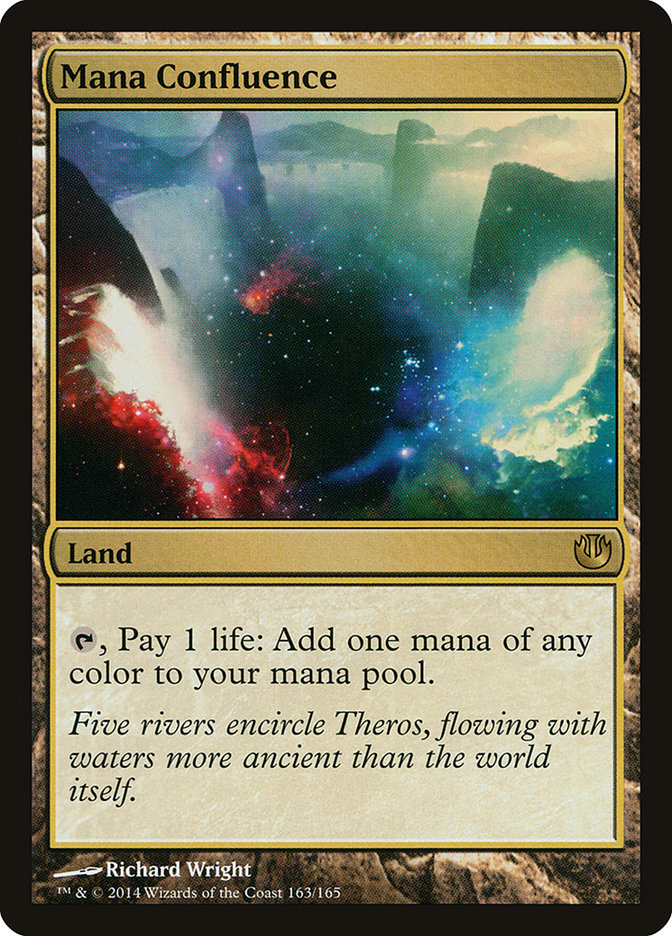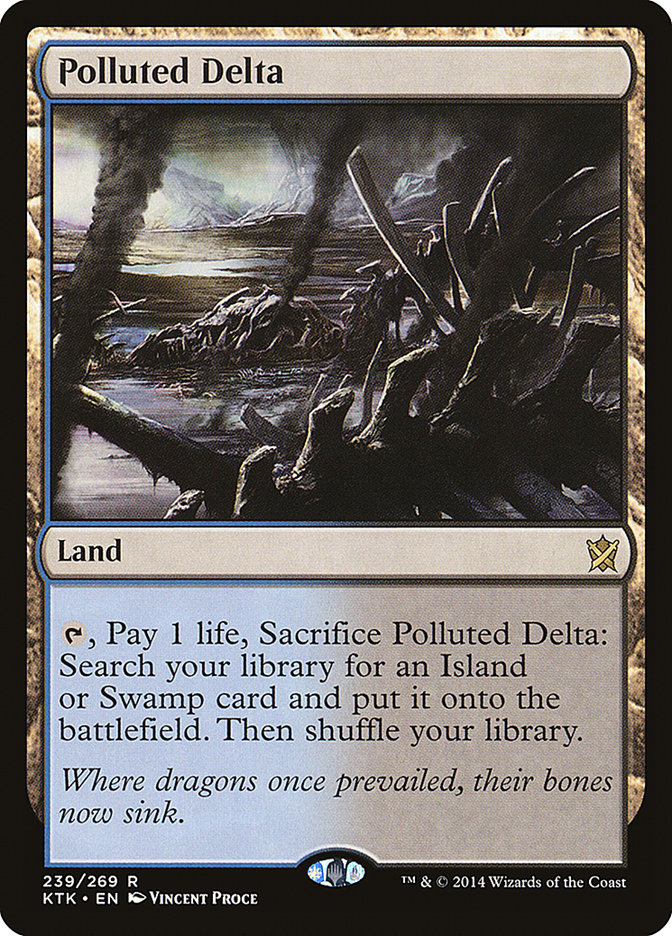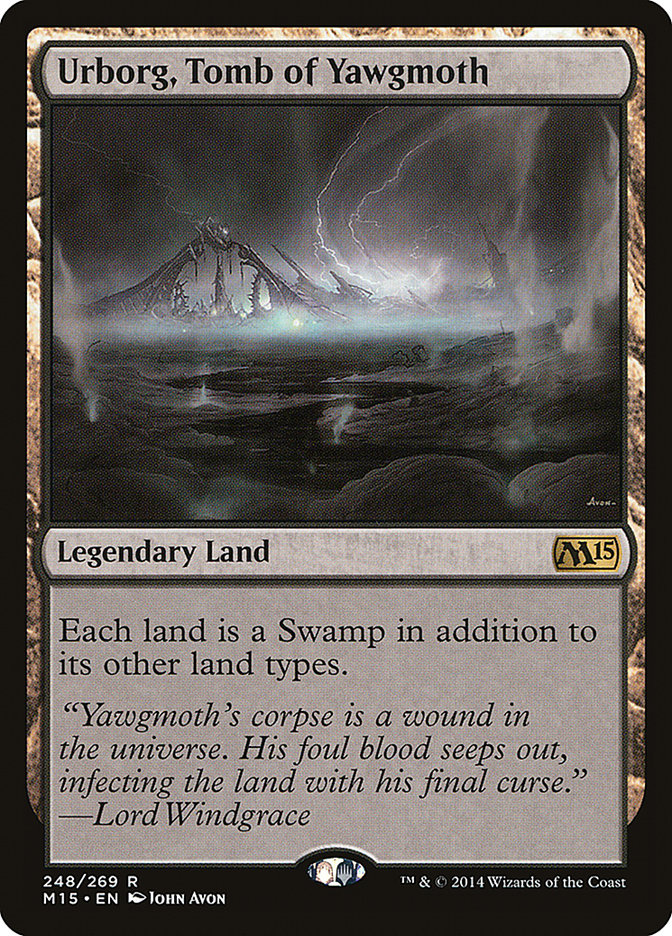Recently, I’ve had manabases on the brain. Standard mana bases are in an especially interesting place at the moment, because while I wouldn’t say the
options are necessarily at an all-time high in quality, it’s difficult to recall so many colors and so many mana-fixing lands simultaneously available. The
rundown:
-Temples in 10 color pairs, smoothing early draws and even other colors via scry
-Taplands in 10 color pairs that gain 1 life
-Trilands in the 5 Khans wedges
-Fetchlands in the 5 allied color pairs
-Painlands in the 5 enemy color pairs
–Mana Confluence and Evolving Wilds, just for good measure
That’s 26 different lands that come into play tapped, and eleven that are untapped but pressure your life total and manabase.
This is actually an incredibly interesting environment for fetchlands, because they’re not the slam dunk playables many people might be tempted to assume
they are. Obviously, these lands are good–I’m not saying they’re not. However, you shouldn’t just be playing a ton of them, and not every manabase can
tolerate even a playset of two colors they’re playing, because at a minimum you’re going to want an equivalent number of basics to fetches–this isn’t
Legacy.
Let’s get an actual example in the mix. Last week, I mentioned
I’d start working on Sidisi decks, and I’ve been doing just that. As chewing your ear off about all the delving I want to do for the third week in a row
would be a bit much, I’m going to refrain from diving really deep into my choices and just give you my latest list, which we’ll use as a case study for how
I’ve been building manabases in Khans.
Creatures (27)
- 1 Hornet Queen
- 4 Elvish Mystic
- 4 Sylvan Caryatid
- 1 Nighthowler
- 2 Prognostic Sphinx
- 2 Courser of Kruphix
- 4 Satyr Wayfinder
- 3 Nyx Weaver
- 2 Soul of Innistrad
- 4 Sidisi, Brood Tyrant
Lands (22)
Spells (11)

I’m happy to answer questions about the deck, though I don’t want to spend the article discussing its spell selection. I know the sideboard looks weird,
but it’s built both for my metagame and based on some very specific approaches to the matchups.
Let’s talk mana. We only need turn 1 G, turn 3 BUG (and preferably BB), along with turn 5 UU. Easy game, right?
One of the resources I use in scenarios like this is
an excellent article
by Hall of Famer Frank Karsten. Frank established some baselines for the sources you need to run in order to be about 90% to cast your spells, and it’s a
great shortcut for building manabases in beta. Here, it’s very important to also keep in mind that, if you play a significant number of taplands, you’ll
also have to adjust to the numbers based on the turn before you’ll want it.  Naturally, tapped lands don’t add mana on the turn you play them; for example,
Naturally, tapped lands don’t add mana on the turn you play them; for example,
a tapped source of black mana only contributes to the black sources you’d need to cast spells on turn 2 or later according to Frank’s charts.
I planned for this deck to run 22 lands pretty much from inception to finish, and I also knew I’d want at least fourteen sources of green mana among my
lands in order to ensure I had untapped green mana starting on turn 2 at the latest. Any hand unable to offer that would be an immediate mulligan, so
maximizing the odds is important. If I could get it up to sixteen I’d be happier with that, but fourteen is my personal line in the sand.
Returning to the fetchlands, savvy mathematicians have likely already made the connection that 4 Polluted Delta + 4 Swamps/Islands leaves exactly the
requisite green sources available for a 22-land deck–with the caveat that every other land in the deck produces green mana. However, consider the nature
of the above deck. It’s a deck based around milling itself for value in a number of slightly randomized ways. It’s quite easy to wind up with a dead fetch
or even two if you run the numbers that close to the wire, so I’ve shaved off one of those fetchlands for Urborg, a powerful mana-fixer in its own right
and one that also allows you to bring empty fetches back to life.
I’ve got a lot of games under my belt with that manabase now, and I’m happy to say I’ve never wound up with a dead Delta, although I’ve thinned the deck
completely of basics more than a few times. That’s basically the ideal scenario, so I’m quite happy with this balance.
Still, I’m far from the finish line. Eight down, fourteen to go!
Opulent Palace was the easiest choice, of course. Producing all three colors in a deck that mulligans every hand without green while wanting turn 3 BB and
turn 5 UU makes it an easy pick. However, Opulent Palace was also a crossroads with regard to Elvish Mystic. I noted I wanted fourteen untapped green
sources starting on turn 2–that’s because fourteen untapped green sources starting on turn 1 was completely untenable given the mana demands of the
remainder of the deck. I could maybe “make it work,” but that would involve all eight painlands and the full four Mana Confluences, which would let me cast
my spells but deal me way too much damage to seriously consider.
That left me with two options: decline to play Mystic, or decide that casting it on turn 2 a significant amount of the time or more was a reasonable goal.
To make that call, I had to first think about all the lines Elvish Mystic opens up in addition to its ability to cast turn 3 Sidisi:
-Scenario A: Turn 1 Mystic, turn 2 Wayfinder + tapland
-Scenario B: Turn 1 Mystic, turn 2 Caryatid + tapland
-Scenario C: Turn 1 Mystic, turn 2 Courser/Nyx Weaver
-Scenario D: Turn 1 Mystic, turn 2 Wayfinder/Commune + Murderous Cut
-Scenario E: Turn 1 Mystic, turn 2 Downfall
-Scenario F: Turn 1 tapland, turn 2 Mystic + tapland
These are pretty strong lines to have available, and Mystic also increases my creature density for Sidisi’s triggers by letting me cut lands. I decided to
make the sacrifice of having “turn 2 Elvish Mystic” be my most frequent timing, as the power level of these options is generally higher than Voyaging Satyr
(though he fixes the mana better). The next step was solving which mix of lands I’d actually use.
We can draw some conclusions from these above scenarios. Scenario A wants me to start with Llanowar Wastes, because that gives me the potential to have
double black for Hero’s Downfall on turn 3 following a turn 2 tapland, assuming my follow-up tapland likewise produces black. Since I know all of these
lands will produce green, this scenario would generally prefer Temple of Malady and Jungle Hollow to follow Llanowar Wastes, with Yavimaya Coast, Mana
Confluence, Polluted Delta, or Island to follow for turn 3 Sidisi while keeping the Downfall option available (especially if the third land is also a
tapland).
Of course, I’d prefer the maximum options for Sidisi, so I’d probably like taplands to exist in about a 1:2 ratio with untapped lands.
Scenario B really doesn’t care too much about any of the lands. Once more, I can make a case for Llanowar Wastes in order to increase the Downfall
potential, but because I’m already probably skewing my taplands toward black it doesn’t really make as huge a difference; triple black is a bit much.
Worth noting is that this scenario can lead to turn 3 Prognostic Sphinx, which is a big game–haven’t lost after doing that yet! To make that happen, I
need to start on Yavimaya Coast or make blue with my tapland. Sadly, Temple of Deceit and its ilk are essentially outlawed given the state of our green
requirements.
Scenario C is the start of a simple curve-out. Any hand that can cast a turn 1 Mystic will be default be able to play Courser, but Nyx Weaver is another
story! Llanowar Wastes again scores the point, with Yavimaya Coast earning a nod for the sake of Sidisi. This is our “ideal” draw, so a manabase should be
built to favor it.
At this point it’s worth comparing Temples to the Khans taplands. Why? Because not only are we shuffling our scrys back in with Polluted Delta, we’re also
losing the top card of the deck to Nyx Weaver constantly. So is gaining 1 life better? Well, yes and no. While it’s true I’ll “always” gain the 1 life and
not always get my scry when it’s useful, the 1 life isn’t going to be useful in many games, and the games in which the scry has impact will typically
involve it having a very significant impact. Scrying into a mana dork for turn 2 or into a topdeck in the lategame is going to shift many more games from
losses to wins, even if it actually occurs in less games.
Scenario D again clearly favors starting on Llanowar Wastes, as that way it doesn’t matter what your second land is as long as it comes into play untapped.
Even though I’m planning to play a lot of black sources, the goal here is to maximize potential. This combination is a surprisingly common start against
decks like Jeskai Tempo. And yes, the Wayfinder-fueled Cut does require the second land to be Polluted Delta… or the first to be Windswept Heath/Wooded
Foothills.
You know, unless you’re like me and constantly whiff on Wayfinder. Of course, either way you need two untapped lands, one that makes green and another that
makes black. Because every land in these fourteen slots must make green, that’s another win for Llanowar Wastes.
Scenarios C and D both also require three untapped lands in order to resolve Sidisi on turn 4, which points towards again playing as few as possible.
Scenario E is another notch for Llanowar Wastes. Urborg allows this start with any green source, and there’s some argument for Mana Confluence… but
Llanowar Wastes is really the safest bet, as I should hope is becoming clear. Ideally I’m avoiding game states that require this start, as developing my
own board is better, but the option is better than nothing.
Scenario F is basically irrelevant, because all of the taplands in the deck are already going to make green mana.
That leaves us with the following start:
2 Swamp
2 Island
Now, I’ve discussed that need for fourteen green sources–what about the rest?
Turn 5 Prognostic Sphinx is looking for eighteen blue mana sources, but the most important blue commitment is actually the twelve or thirteen you’ll need
to enable Sidisi, Brood Tyrant. Because Sphinx is essentially a closer for attrition matchups and because Wayfinder can help you find the second blue a
little more often, I don’t mind dropping below the line for Sphinx as long as I have Sidisi locked up.
My current manabase provides nine blue sources from the lands and four from Sylvan Caryatid. However, among the matchups I want Sphinx the most are decks
that are slow and grindy–decks against which I’d like to board out some Caryatids, especially if they have Anger of the Gods or some other sweeper. If I
play four more lands producing blue, that’ll get me to thirteen sources, Caryatid or no! That means I’m playing four Yavimaya Coast/Temple of Mystery, and
while playing the deck I became happy with prioritizing the painland. I’m keeping one Temple for now, but I could see losing it for the last Coast. I won’t
be a great Sphinx deck without Caryatid, but I can suffer through and the ability to cast Sidisi will be satisfied.
Turn 3 Hero’s Downfall will essentially require twenty sources of black, as many of them will have “summoning sickness” whether it’s through Caryatid or a
tapland. Urborg is basically freerolling–I wouldn’t weight it much differently than a Swamp, though it is.
Similarly, you can fudge the numbers a bit for Satyr Wayfinder. This wasn’t an option with green mana because any hand that can’t cast Wayfinder is a
mulligan anyway, but the Wayfinder is a legitimate aid for fixing other colors. However, if I can build the manabase to supply the right sources without
leaning on him, I’d certainly prefer to do that.
The above lands provide fourteen sources of black, while Sylvan Caryatid grants me four more. That means I only need two more sources of black among my six
remaining lands to hit the baseline for 90%. The options are Evolving Wilds (which requires a Forest), Mana Confluence (ouch), or Temple of Malady. I think
Evolving Wilds would be totally reasonable to play over Temple as long as you follow the same rules as Polluted Delta, but you can be a touch looser with
the ratio since the Swamps and Islands also provide you with mana-producing selections. Still, the more you stress basic access the more variance you leave
yourself open to due to Commune, Weaver, Sidisi, and even a particularly naughty Wayfinder. I’m not ruling out the Wilds yet, but I’ve been liking the
Temples even at their worst.
If you wanted to try and force Evolving Wilds, you’d probably just play 3 Evolving Wilds and 3 Forests following the initial base posted above, but that’s
pretty gross. I’d probably have to trim a Delta for another Island in order to feel comfortable with that, and that’s a lot of Islands to play in a deck
that’s essentially splashing blue. Also keep in mind that while Evolving Wilds technically is a source for all three colors, it can only actually provide
one of them–that’s weak fixing over multiple turns compared to a Temple, even if it does boost delve.
Returning to the finishing touches here. Thanks to Wayfinder I’m accessing slightly more black than I need to hit my 90% benchmark. However, if I’m cutting
Caryatid from my deck in sideboarding some of the time, this is clearly still a bit greedy unless I also am cutting down on double-black spells, which
wouldn’t occur given the attrition matchups being when I’d want to do it. Going so low on lands means that cutting mana dorks can leave you a little light
on mana-producing cards in total, so I decided to kill two birds with one stone here by sideboarding an additional copy of Urborg. I can add a land to my
deck and it’ll also boost my ability to produce double-black. This is especially relevant for the matchups in which I go up to triple Bile Blight–for
example, against Jeskai Tempo I take out all of my Sylvan Caryatids but still want the black mana to let me play my removal spells early.
That gives me the following finished product, at least where manabase is concerned:
2 Island
2 Swamp
Sideboard:
You could add a Mana Confluence, maybe even two, but I haven’t had issues playing my spells with the above manabase so taking that risk doesn’t appeal to
me. The math seems to have essentially paid off, and while I’m not certain if I hit things perfectly on the head with this manabase, I do know I’ve hit it
close enough to be difficult to even discern a better setup, which bolsters my confidence. There were a few… less favorable iterations, but this one has
hummed along swimmingly.
And that’s how you wind up playing four Elvish Mystic and zero Forests in Standard.


